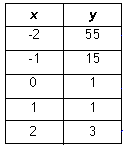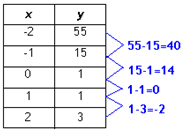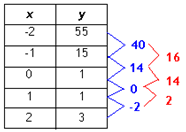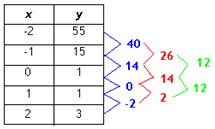Tables
| Site: | St. Louis |
| Cours: | Michigan Algebra I Sept. 2012 |
| Livre: | Tables |
| Imprimé par: | Visiteur anonyme |
| Date: | dimanche 30 novembre 2025, 06:28 |
Description
Tables
Introduction
Example 1 Determine the function that models the table below: 
Step 1. Determine the zeros of the function.
(-5, 0), (1, 0), (3, 0)
Step 2. Turn each zero into a factor of the function.
Since x = -5, then (x + 5) is a factor of the polynomial.
Since x = 1, then (x - 1) is a factor of the polynomial.
Since x = 3, then (x - 3) is a factor of the polynomial.
30 = a (0 + 5)(0 - 1)(0 - 3)
30 = a (15)
2 = a
Finding Differences
If you have a set of data with equally spaced x-values, you can find the lowest possible degree of a polynomial function that fits the data, if there is one, by analyzing the differences in the y-values. This technique, the finite differences method, determines only the degree of the polynomial. The steps are as follows:
Method of Finite Differences Algorithm
- List the terms as a sequence of numbers.
- Find the differences between successive terms until a constant is reached for every difference.
- Count the number of times it was necessary to subtract to get a common difference.
- The number of subtractions is the degree of the polynomial describing the sequence.
Example

Step 1. Make sure the x-values are in equal increments.
The x-values of the table are increasing by one.
Step 2. Find the first difference of the table.

Example Continued

Since the second difference is not constant, the polynomial is not a quadratic.
Step 4. Find the third difference.

Since the third difference is constant, this table can be modeled by a third degree polynomial.
Video Lesson
Degree of Polynomials
Guided Practice
Guided Practice
Practice
Answer Keys
Sources
Boast, Steve. "Finding Differences Lab." 08/02/2000. webs.wichita.edu/facsme/cbl/algebra2/finitedif.pdf (accessed 08/12/2010).
Embracing Mathematics, Assessment & Technology in High Schools; A Michigan Mathematics & Science Partnership Grant Project
Holt, Rinehart & Winston, "Polynomial Functions." http://my.hrw.com/math06_07/nsmedia/homework_help/alg2/alg2_ch06_09_homeworkhelp.html (accessed 9/8/2010).
Holt, Rinehart & Winston, "Using Finite Differences to Determine Degree." http://my.hrw.com/math06_07/nsmedia/lesson_videos/alg2/player.html?contentSrc=6459/6459.xml (accessed 9/8/2010).
Texas Instruments, "Count the Differences." http://education.ti.com/educationportal/activityexchange/Activity.do?cid=US&aId=12091 (accessed 08/12/2010).